Moore Park: Discover sport and history in this Sydney suburb
A Self-Guided Walk in Moore Park
There is a bounce in my step as I think about the day ahead. After a subscriber suggested I add Moore Park to my list (she grew up there), a quick internet search revealed that the Moore Park of today is mostly sporting facilities and parkland, and I rejected the idea.
However, after taking my grandson for a walk through the area, I realised that Moore Park has plenty to write about.
Setting Out
My exploration begins where South Dowling Street meets Moore Park Road. A silver painted metal gate between two imposing sandstone gate posts leads nowhere and I walk along the adjacent path towards a low grey wall.
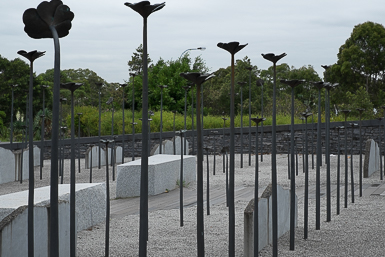
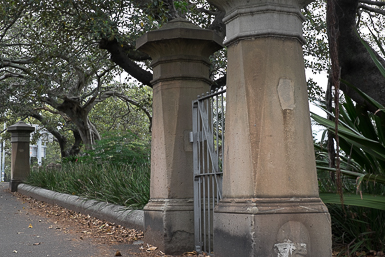
Korean War Memorial
Lettering on the wall indicates that this is a memorial to troops who served in the Korean War. Trying to get a good angle for a photo, I lean over the wall and am startled by the unexpected sight of a man sleeping rough, his head covered by a blanket. There’s a mall satchel lying by his side.
The nearby gazebo or bandstand appears to be part of the memorial. Party goers have left a box of empty beer bottles and other rubbish littering the floor.
Entry to Moore Park (the park)
Two more sandstone pillars at the start of ANZAC Parade formed part of the original entry point to Moore Park. The park was named after the City of Sydney Mayor who persuaded council to keep the land for parkland. Established in 1866 Moore Park is one of three parks making up the Centennial Parklands.
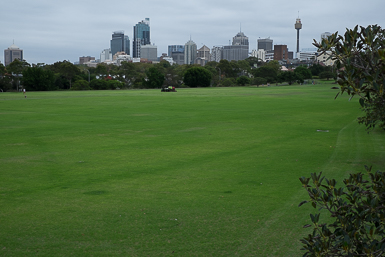

Runners and dog walkers enjoy the open grassland while I take in the scent of freshly cut grass as a ride on mower chugs up and down mowing the lawn.
Albert ‘Tibby’ Walkway
At the far end of the field, the Albert ‘Tibby’ Cotter Walkway provides safe and easy pedestrian access to the sports complexes. Named after an Australian fast bowler and ANZAC, the walkway curves round and around providing grand views over the parkland to the city. Information plaques tell me about Albert Cotter, the history of Sydney Cricket, the ANZACs and the Gadigal people who first walked these lands. I wonder how many people actually stop to read them.
As Allianz Stadium (previously Sydney Football Stadium) comes into view, I recall the current controversy surrounding the proposed rebuilding of the stadium.
A shirtless young man, his torso covered in colourful tats is exercising with two others at a fitness station near the end of the walkway. A fourth arrives with his radio blaring hip hop music. I would love a photo of the tats but can’t quite bring myself to ask for one.
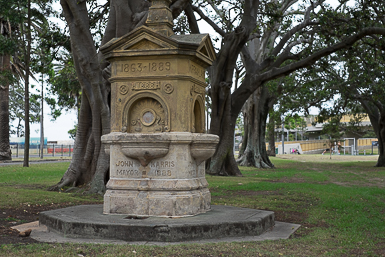
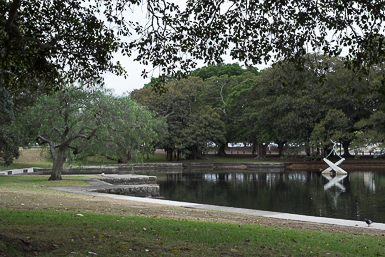
Kippax Lake
Close by is Kippax Lake, once known as Nanny Goat Swamp, and later used for model boat regattas. Today the central sculpture, representing women in sport, is reflected in the still water while waterbirds swim towards me looking for food.
Rugby League Central is over the road. A man confused about where he is. I put him right and he directs his Uber driver more accurately.
Sydney Cricket Ground and Sports Trust
Life size bronze statues of famous sports stars line the entrance to Allianz stadium. Not really a follower of sport, I only recognise Betty Cuthbert.
Although I can see the entrance to the League and Legends Museum, I can’t get in. Perhaps I’d have to do one of the daily 90-minute tours of the SCG to enter. I know the tour does include the Cricket Museum where Bradman’s bat and baggy green are on display.

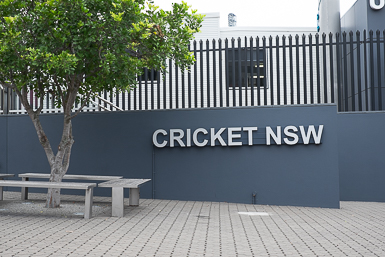
Arthur Morris’s initials decorate the tall metal gates names in his honour. Nearby, the members entrance to the SCG is closed for now. Crossing the road, I get a better view of the old brick building with its green corrugated iron roof.
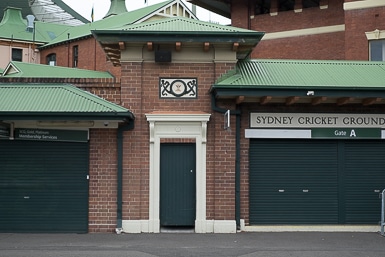

Sydney Swans
A bronze statue of Paul Kelly (captain of the Swans for 10 years) marks the entrance to the Sydney Swans headquarters. Three boys are hanging around, seemingly aimlessly. A young man comes out and asks them something, then offers to get them a pen and paper. Later I see them walking off with Swans Team posters and big smiles on their faces.
Now, the old Sydney Showground wall is on my left. While the Sydney Royal Easter Show moved to Homebush a long time ago, the Vice- Regal entrance remains. Unfortunately, the informative signs are defaced and almost illegible.


Entertainment Quarter
Beyond the professional entry to Fox Studios, is the Entertainment Quarter entrance and the Byron Kennedy Hall with its distinctive bell tower. A group of Sydney Swans players in their distinctive red and white attire walk past. Unfortunately, I have no idea who they are.
Walking around the original showring, closer inspection reveals that what seemed to be a building is actually a temporary structure. Bits of card and polystyrene are scattered around. A builder working on the project tells me that the façade was built as a decorative structure and is being restored. He says it “must be about 20 years old”.
He points out the words “Australia’s 150th Anniversary” etched boldly in the sandstone wall of the Commemorative Pavilion which I hadn’t even noticed. These days the pavilion is a Fox Studios stage.
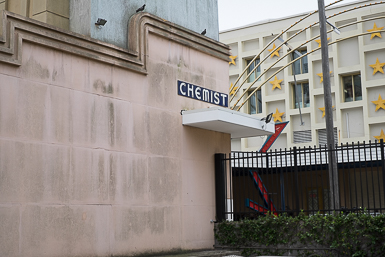
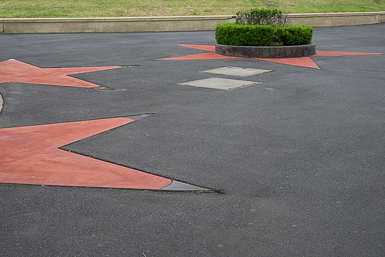
Rows of half buried sandstone blocks provide seating in a sloping grassed area. Perhaps show goers sat watching events in the showring. Further on a plaque commemorates the speedway riders and drivers who competed on this site between 1926 and 1996. Another bit of history.
Aboriginal Artwork
A large black and white mural (by Jacki Giles) draws my attention. Walking there, I pass, signs outside the Australian Film and Television Radio School which reveal that The Dairy Pavilion, the Agricultural Hall and the Main Pavilion were located here.


Black Star Pastry
People are staring through a large viewing window, watching pastries being assembled at Black Star Pastry. A man cuts large rectangular blocks of watermelon into slices for their famous watermelon cake.
Leaving the Entertainment Quarter via Errol Flynn Blvd I pass the Hordern Pavilion and the Royal Hall of Industries and follow the high brick wall on my left.

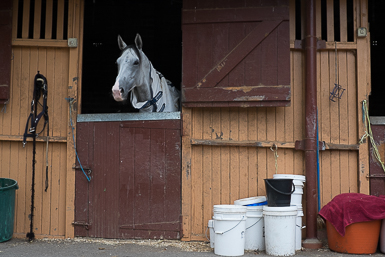
The Equestrian Centre
With Centennial Park on my right, I walk towards the Equestrian centre. City people stable their horses here. While, owners must check on their horse every day, I get the feeling that the horses are lonely, and I spend a few minutes chatting to a couple.


Turning away from the parkland, the high wall of the original showground continues. The houses, and apartment blocks on my right (officially the suburb of Centennial Park) are a jumble of new and old architecture. I wonder if my reader’s home still stands.
Moore Park Road takes me back to the sports facilities and more statues of sporting icons. Through the window of the Rugby Australia building I see two shiny silver trophies stand on the receptionist’s desk.


Back to the Beginning
Having come almost full circle, I walk back through parkland where I make two more discoveries. A Moreton Bay Fig commemorates the 30th anniversary of the Sydney Gay and Lesbian Mardi Gras. Doing the maths, I realise that this year will be the 40th anniversary and wonder what will mark this celebration?
Further on, the ANZAC Obelisk of 1917 stands in its new permanent site. It was moved from ANZAC Parade when the Albert Cotter Walkway was built.
The homeless man who spent the night in the Korean War memorial has gone and my discovery of Moore Park is over. Moore Park is mostly parkland and sporting facilities, but there is history here and plenty to explore.
Useful information:
The small suburb of Moore Park is 3km south east of the Sydney CBD
Plan your trip at transportnsw.info
Learn more about the Sydney Cricket Ground Tour here
Walking Map
And a map to assist you: You can download it here.
(NOTE that the time indicated on the map does not allow for any stops. I take an average of 4-5 hours when I explore):
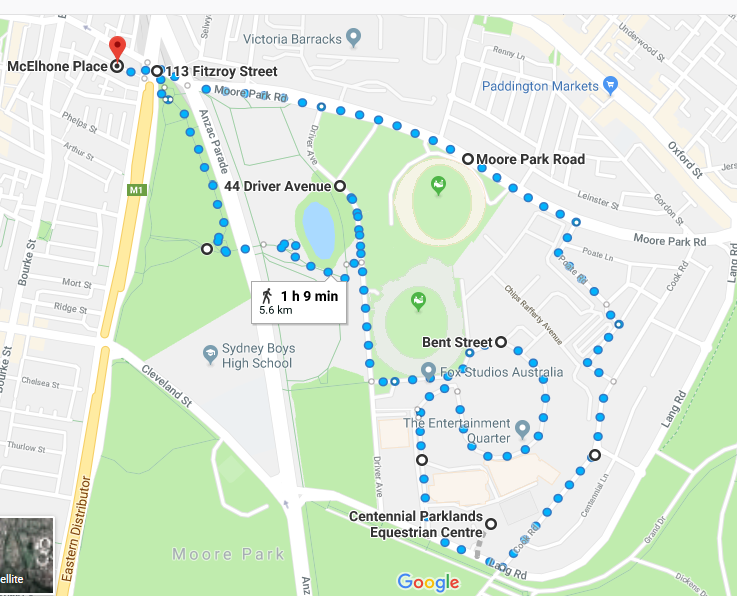

If you’d have kept going along Anzac Parade instead of crossing over the bridge you’d have reached my alma mater, Sydney Boys’ High School. It used to be the Sydney zoo before it moved to Taronga and in the common ground between the boys and girls schools the old bear pits are still there, one plainly visible from Anzac Parade. It used to be known as “Billy Goat Swamp” back in the old days.
Thanks David for that additional information. I didn’t know about the zoo. It’s a pity I didn’t get there. Jo
Thanks for your post. I love your photo of the Albert Tibby Walkway…….it shows a great perspective view. I’m also curious about the “watermelon” cake from Black Star Pastry…. I will have to look up recipes to see how to make one of those.
Thanks Bernadette. The cake is a layered cake with biscuit type base, sponge, cream, watermelon and a pretty toppling with edible flowers. Apparently one of the most instagrammed cake….
We lived in Sydney for a few months and this brings back some lovely memories of the day we went for a walk around Moore Park. Thanks.
I’m pleased it brought back pleasant memories.
Hey Joanne! I didn’t know aboriginal artwork can be done in white and black as I often see those with colorful stuffs. Beautiful post as always. Thanks for touring us in some parts of Sydney.
Yes – like all art it comes in different shapes and forms. The work in Moore Park is actually carefully crafted from black and white metal pieces. Quite stunning.